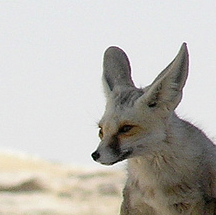Jarbufoix are a small fox species that live deep in the deserts of Calia and savannas of Rylsk. It should be noted that killing or eating a Jarbufoix is considered a heinous offense in Melivora culture, as it is the favored form of the god Eorthere. Some travelers have attempted to export these little creatures into different parts of the world, however, they always seem to find themselves back in their native lands. They generally live up to eighteen years.
Description
Jarbufoix are one of the smaller omnivores to exist in the arid deserts, with the largest recorded of its species being only a foot tall. With their large ears and small frames, an uneducated traveler might quickly assume it to be a rodent and attempt to capture and feed on it; whispers have been heard of visitors meeting their untimely deaths for such a blasphemous act but none have been proven. They have pelts the color of earth or sand, with rare cases of albinism and melanism in between. Their markings often vary from stripes to spotted-stripes to faded spots - there have been recent claims, however, that there are rare wild Jarbufoix decorated with the golden rosettes of Eorthere.
Jarbufoix are known to stand on their long hind legs, hopping from one location to another, and their forelegs are noticeably shorter but tipped with large, heavy claws. To aid in their balance, their tails are thick and longer than their bodies, ending with a tufted tip. This tail helps them walk and run using only their hindlegs, and can even be used to prop themselves up when they are standing still. Their skulls are forward-shifted to aid in balance. Their large, powerful ears help dissipate heat but are highly sensitive to pain, with many blood vessels found close to the skin. Their paws are covered with thick fur to protect them from the searing sand.
Social Behavior
Jarbufoix have a life span of sixteen years but can be longer when tamed. A mated pair lives only with each other until they form a family of their own. In the wild, newborns (called 'kittens') temporarily live in their familial group until their mother has given birth to a new litter - they then leave their burrow to make a family of their own, leaving their parents to themselves again.
Their burrows are dug into the earth, usually near plant life, trees, or rocky outcrops, and are mainly composed of the main tunnel, several side tunnels, three different sleeping chambers, and two emergency exits. Each burrow opening is usually shielded with whatever dried plant, leaf, root, or material that the Jarbufoix pair can get their claws on - this is both to obstruct hot air from entering their burrow and to keep out predators.
A typical day for a mated pair consists of cleaning the den in the morning before setting out to hunt. In the hottest part of the day, Jarbufoix find a cool patch of shade and carefully bury their bodies into the sand until only their noses are poking out of the ground. After around an hour, they resume their meal-search before returning home and grooming each other before nightfall.
Reproduction
Sexual maturity is reached at around six months. Jarbufoix are monogamous and stick with their partner for life after mating, producing more offspring over the years. Males usually become more aggressive and protective of females right after copulation. Mating rituals begin by the male carving out the main entrance of a burrow that he and his potential mate can move into. Each refusal of the female is another side tunnel built until the female is satisfied.
Female Jarbufoix breed three times in a year and have litters of two to six. Their gestation time is between 35 to 40 days. Both parents are highly invested in their litter. The mother stays in the den while the litter suckles and the father goes out to hunt and bring home food for his partner. When the kittens are weaned, usually around the first month, the father stays home to protect the burrow and the mother is tasked to hunt. This is, generally, the only time a mated pair will be separate.
Diet and Feeding
Jarbufoix are mainly omnivores and may feed on smaller rodents, insects, birds, eggs, or rabbits, as well as grass, shoots, fruits, a variety of flower buds, cacti, and succulents. Their large ears help them listen to burrowed prey, which they then proceed to dig up with their paws. They have a particularly effective digging method with the way their fore-claws are set up, using two thick claws to drive into the sand and using the last two to sweep them away. Jarbufoix can also spring up date palms to eat their fruits.
During paired hunts, one Jarbufoix will keep an eye out for predators while the other focuses on finding food. Jarbufoix eat as they go and will take turns taking a bite out of what they got before eyeing the skies as the other takes their turn. It's a repetitive habit that is also reflected when an unmated individual hunts - they take a bite, spends the next couple of seconds eyeing their surroundings, before taking another bite.




Comments
Author's Notes
Cover Image by: Thomas Bewick